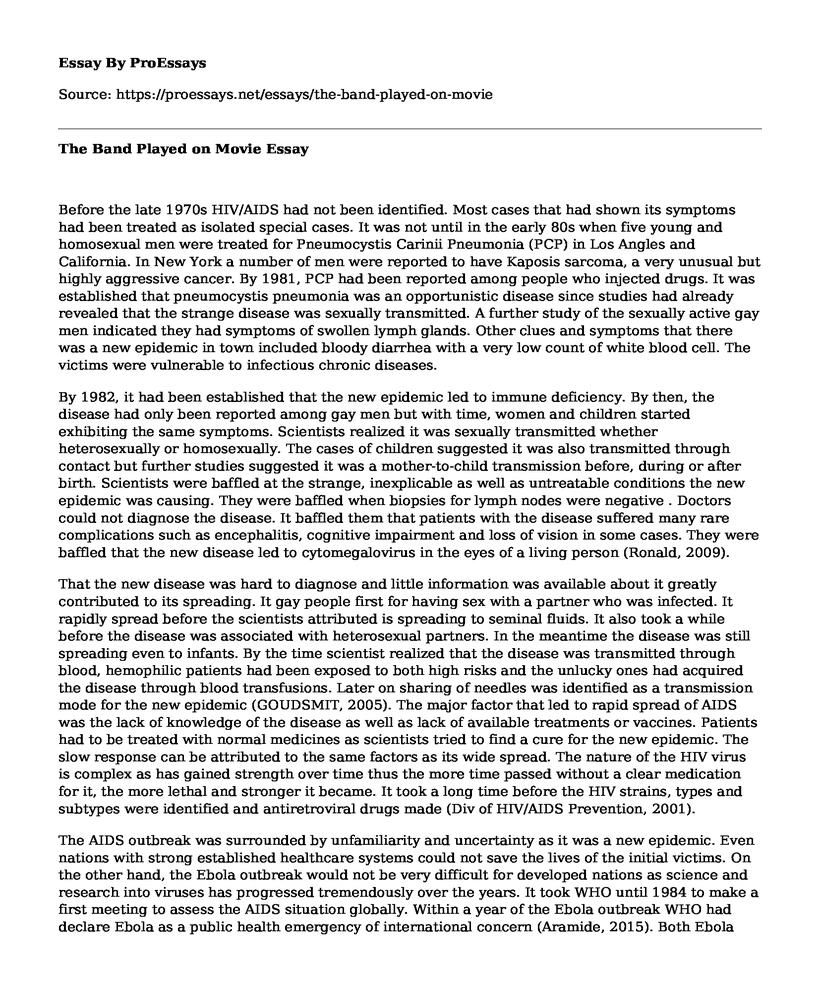Before the late 1970s HIV/AIDS had not been identified. Most cases that had shown its symptoms had been treated as isolated special cases. It was not until in the early 80s when five young and homosexual men were treated for Pneumocystis Carinii Pneumonia (PCP) in Los Angles and California. In New York a number of men were reported to have Kaposis sarcoma, a very unusual but highly aggressive cancer. By 1981, PCP had been reported among people who injected drugs. It was established that pneumocystis pneumonia was an opportunistic disease since studies had already revealed that the strange disease was sexually transmitted. A further study of the sexually active gay men indicated they had symptoms of swollen lymph glands. Other clues and symptoms that there was a new epidemic in town included bloody diarrhea with a very low count of white blood cell. The victims were vulnerable to infectious chronic diseases.
By 1982, it had been established that the new epidemic led to immune deficiency. By then, the disease had only been reported among gay men but with time, women and children started exhibiting the same symptoms. Scientists realized it was sexually transmitted whether heterosexually or homosexually. The cases of children suggested it was also transmitted through contact but further studies suggested it was a mother-to-child transmission before, during or after birth. Scientists were baffled at the strange, inexplicable as well as untreatable conditions the new epidemic was causing. They were baffled when biopsies for lymph nodes were negative . Doctors could not diagnose the disease. It baffled them that patients with the disease suffered many rare complications such as encephalitis, cognitive impairment and loss of vision in some cases. They were baffled that the new disease led to cytomegalovirus in the eyes of a living person (Ronald, 2009).
That the new disease was hard to diagnose and little information was available about it greatly contributed to its spreading. It gay people first for having sex with a partner who was infected. It rapidly spread before the scientists attributed is spreading to seminal fluids. It also took a while before the disease was associated with heterosexual partners. In the meantime the disease was still spreading even to infants. By the time scientist realized that the disease was transmitted through blood, hemophilic patients had been exposed to both high risks and the unlucky ones had acquired the disease through blood transfusions. Later on sharing of needles was identified as a transmission mode for the new epidemic (GOUDSMIT, 2005). The major factor that led to rapid spread of AIDS was the lack of knowledge of the disease as well as lack of available treatments or vaccines. Patients had to be treated with normal medicines as scientists tried to find a cure for the new epidemic. The slow response can be attributed to the same factors as its wide spread. The nature of the HIV virus is complex as has gained strength over time thus the more time passed without a clear medication for it, the more lethal and stronger it became. It took a long time before the HIV strains, types and subtypes were identified and antiretroviral drugs made (Div of HIV/AIDS Prevention, 2001).
The AIDS outbreak was surrounded by unfamiliarity and uncertainty as it was a new epidemic. Even nations with strong established healthcare systems could not save the lives of the initial victims. On the other hand, the Ebola outbreak would not be very difficult for developed nations as science and research into viruses has progressed tremendously over the years. It took WHO until 1984 to make a first meeting to assess the AIDS situation globally. Within a year of the Ebola outbreak WHO had declare Ebola as a public health emergency of international concern (Aramide, 2015). Both Ebola and AIDS are epidemics that the WHO organization raised a red flag on as it is mandated to care for global health issues.
References
Aramide, O. (2015). The Ebola Virus Disease: Problems, Consequences, Causes, and Recommendations. The journal of degenerative diseases.
Div of HIV/AIDS Prevention, N. C. (2001). HIV and AIDS --- United States, 1981--2000. 430-434.
Goudsmit, J. (2005). Viral Sex: The Nature of AIDS. Newyork: Oxford University Press.
Ronald, G. M. (2009). AIDS Doctors: Voices from the Epidemic. New York: Oxford University Press.
Cite this page
The Band Played on Movie. (2021, Apr 22). Retrieved from https://proessays.net/essays/the-band-played-on-movie
If you are the original author of this essay and no longer wish to have it published on the ProEssays website, please click below to request its removal:
- Argumentative Essay Sample on Abortion
- Pregnant Women Need Nutrients for Healthy Baby: Know Why
- Essay Example on Florence Nightingale: Pioneering the Science of Modern Nursing
- Essay Sample on Effective Dissemination of Nursing Evidence: Evaluating Appropriate Methods
- Essay Sample on HIM & HIT: Enhancing Quality of Care Through Data Use
- The Social Determinants of Health & Poor Environmental Health - Essay Sample
- Paper Example on Prevalence and Support for Domestic Violence Survivors Presenting at Emergency Departments







